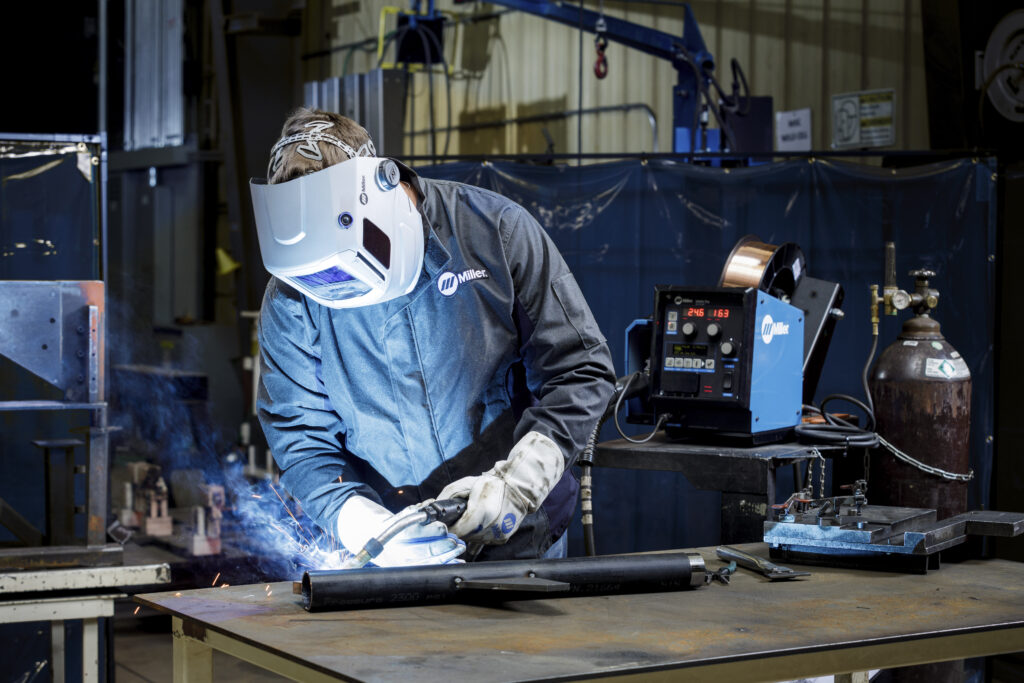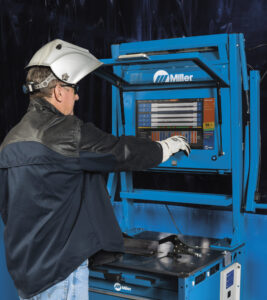 Keep Operations Competitive
Keep Operations Competitive
The welding industry faces a pressing challenge in the growing lack of skilled welding operators. While this is not a new problem, it is an issue that many contractors, fabrication shops and manufacturing operations struggle with every day as they work to keep their operations competitive.
According to the American Welding Society, the industry will face a shortage of about 400,000 welding operators by 2024. This is due both to a lack of incoming skilled welding operators, as well as the aging population of the current welding workforce — in the United States the average welding operator is 57 and poised for retirement.
The two primary methods for the industry to address the welding operator shortage are increasing the labor pool by training more operators and increasing productivity with the existing welding workforce.
In response to this industry challenge, welding equipment manufacturers are developing innovative technologies to make it easier and more cost-efficient to recruit and train talent in the industry. Some of these same technology advancements can also be used to help requalify existing employees to build their skills.
New advanced welding processes also offer greatly increased productivity through higher deposition rates and a stable, easier-to-control arc that can help reduce weld failures, so contractors, manufacturers and fabrication shops are able to complete more code-quality welds faster with their existing labor pool, helping them ease the demand for welding operators.
In addition, some contractors are forming training and partnership initiatives with union organizations to help retrain current welding operators in higher productivity welding processes.
All of these efforts combined can help contractors, manufacturers, fabrication shops and other welding organizations adapt to the challenges posed by the skilled labor shortage and establish a more competitive, productive welding operation.
Simpler Designs, Intuitive Products
Welding equipment manufacturers are stepping up with easier-to-use and more intuitive equipment solutions, which can help address the welding operator shortage.
 Specifically, technology improvements have resulted in power sources with simplified interfaces, making it easier to complete superior welds — even among welding operators of varying skills sets — and also to set up and operate the machines. Examples of such advancements include features like preset weld parameters that can be established with the push of a button, quick process changeover and point-of-use controls. The preset parameters are based on process wire type and diameter and shielding gas type, and the systems can also limit options based on previous variables selected by the welding operator.
Specifically, technology improvements have resulted in power sources with simplified interfaces, making it easier to complete superior welds — even among welding operators of varying skills sets — and also to set up and operate the machines. Examples of such advancements include features like preset weld parameters that can be established with the push of a button, quick process changeover and point-of-use controls. The preset parameters are based on process wire type and diameter and shielding gas type, and the systems can also limit options based on previous variables selected by the welding operator.
These technologies can provide exceptional performance, improve productivity and reduce rework — all factors that help maximize labor hours and make the welding process easier for the operator.
These equipment advancements help in two ways. First, they allow an employer to open up the labor pool to attract more welding operators who can be trained to produce high-quality welds. Second, the productivity gains make the existing workforce more productive. In an industry struggling to attract enough skilled welding operators, maximizing the current labor pool is important.
Improve Productivity With Advanced Procedures
While equipment advances and simpler technologies are important steps to help the industry address the welding operator shortage, it’s also important for contractors, manufacturers and fabrication shops to look at business drivers and find additional ways to become more efficient.
Labor is a large portion of the cost of a weld in North America — about 80 percent of the cost in field welding, for example. Therefore, finding ways to increase productivity is the biggest cost savings opportunity for these employers.
Advanced welding processes, such as Pulsed MIG or modified short-circuit MIG, offer greater simplicity and can be easily taught and learned. This speeds up training, making it easier for welding operators to gain the training and experience necessary to create quality welds. In addition, these advanced processes are more forgiving to variations in stickout and offer exceptional arc stability, which is easier to control and can help avoid weld defects.
Wire processes offer higher deposition rates compared to Stick and TIG, increasing productivity. In addition, advanced wire processes such as Pulsed MIG and modified short-circuit MIG address previous quality issues regarding conventional wire processes, making the advanced processes viable options for completing code-quality welds.
Once an operation decides to change welding procedures to take advantage of a more productive process, training new welding operators and retraining the existing workforce are often necessary. The new welding procedures and equipment must be certified, and welding operators must be certified on the new processes as well.
Growing Training Partnerships
More training partnerships and collaborations are forming to help address this retraining need as welding operations switch to advanced welding processes and equipment to improve productivity.
One example involves the United Association of Journeymen and Apprentices of the Plumbing and Pipe Fitting Industry of the United States and Canada (UA), a union affiliated with the national building trades that represents welders and pipefitters. The UA has partnered with a top national contractor to develop a program to proactively train already skilled welding operators in the new advanced welding procedures based upon the materials and parameters of specific applications and requirements for this particular contractor.
It’s an example of a major contractor understanding that it can switch to the latest welding technology and greater-productivity procedures, but without enough qualified welding operators to complete the jobs, it can’t fully realize the productivity gains and cost savings.
Some contractors are also working with technical colleges to develop training programs, or they are building their own in-house training facilities. This allows them to hire employees and train them to meet specific welding needs.
In addition to the partnerships forming between contractors and union training halls and contractors and technical schools, many welding equipment manufacturers offer training centers and programs to provide expertise and resources for employers, contractors, unions, distributors and other end users.
 Technology is also playing a role in training and retraining. Among the new technologies that can help address the labor shortage are new training systems that contribute to faster and easier operator training. One system on the market is designed to deliver a real-world, arc-on welding experience by using motion-tracking technology.
Technology is also playing a role in training and retraining. Among the new technologies that can help address the labor shortage are new training systems that contribute to faster and easier operator training. One system on the market is designed to deliver a real-world, arc-on welding experience by using motion-tracking technology.
The motion-tracking cameras provide immediate feedback on technique parameters during initial simulation mode and also during live arc training mode. The system uses a real welding power source with a MIG gun. With the push of a button, operators can experience a real welding arc while transferring the learned muscle memory and proper welding technique into a real welding application.
This type of new technology offers a faster, more cost-effective method for screening applicants and training new welders, and it is an effective way to retrain current welding operators on new parameters. Welding operations can use this type of technology to maintain or update the skills of their current welding operators, by creating specific training assignments based on existing welding operations.
Keys To Addressing The Shortage
In the quest to recruit and train more welding operators — and retrain the current welding workforce — to meet current and future industry demands, new technologies and equipment that are easier to learn and use will be an important part of the solution.
In addition, switching to more productive advanced welding procedures is another solution that can benefit many contractors, fabrication shops, and manufacturers and help them maximize the current welding labor pool. Understanding the potential productivity gains offered by advanced welding processes and new technologies can help an organization ensure that contracts are completed on time — and on budget.
Growing partnerships and training initiatives are also among the key steps that will help organizations address the challenges posed by the welding operator shortage — while also helping to increase productivity of the welding operation through new technology and advanced processes.



















